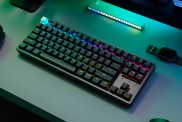A quick kill.
Does a gourmet dish taste better when there’s less of it? Hunger being the best spice, we’re always going to want more of a good thing until we’re satisfied.
And we want more Genji. Sony’s samurai showstopper turns out to be a prime example of how to prepare an audience for a sequel, giving just enough to warrant praise, but ultimately dissolving too soon to earn top honor.
Genji‘s mythology revolves around Amahagane, magical stones that grant their bearer the power of Kamui. When activated, this power allows the warrior to see through enemy attacks and counter it with stylish, lethal force. The Heishi clan defeated the Genji family through the use of these stones, and have since become brutal rulers of their surrounding territories. As Yoshitsune, son of the late Genji general in the Heishi war, your quest is to fulfill your destiny by finishing the job your father started. Armed with your own Amahagane, you must take down each Heishi general and fuse their Amahagane with yours in order to overthrow the ruthless Heishi clan.
 Aside from a Cup O’ Noodles worth of minor plot segues, that’s pretty much the gist of the story. Each boss fight ends with getting another magical stone and fusing it to “unleash your Amahagane’s true power,” which just means you get another special meter extension. It’s kind of a letdown in general, especially after all the drama behind it, but it’s not much of a problem since the combat is so fun.
Aside from a Cup O’ Noodles worth of minor plot segues, that’s pretty much the gist of the story. Each boss fight ends with getting another magical stone and fusing it to “unleash your Amahagane’s true power,” which just means you get another special meter extension. It’s kind of a letdown in general, especially after all the drama behind it, but it’s not much of a problem since the combat is so fun.
Genji‘s control scheme should be instantly familiar, with quick melee attack combos, dodges, and jumping attacks. It sets itself apart through the use of Kamui, the power behind your Amahagane. A special meter charges up as you combo your way through enemies; when you trigger Kamui, every enemy in the area backs up, regroups, then attacks. Time is slowed down during this period, and if you time it correctly, you’ll slice through either a group of them or one after the next in cinematic satisfaction – much like God of War‘s cinematic kills with a focus on timing rather than button sequences. If the timing window is too brief, you can use that extra special meter to slow time even further. The whole thing works well and really gives a sharper edge to the combat.
After a few battles, Yoshitsune will run into another proud member of the fallen Genji family, Benkei, a seven-foot tall monk who wields monstrous clubs and spears. Playing as either character, you’ll rush through feudal Japan owning enemy thugs, waxing bosses, and grabbing power-ups and items in traditional third-person action game fare. Though the template is familiar, the action keeps from being stale by the variation of their opposed, though equally rewarding, play styles. Yoshitsune is up-close, fast and tight, while Benkei is a far-reaching tank with charged attacks. As soon as you hit terminal attention span with one, you can always switch to the other.
 Being that Yoshitsune and Benkei share experience points, items and money, it doesn’t make much of a difference which one you favor. You can choose where to spend certain pickups to boost either of their Health, Attack or Defense parameters, so there’s a trace amount of customization. Certain areas might have a tree trunk barring the way or a high wall that needs to be scaled, so you will have to go back and replay it with the other character to totally clear it out. Though this is entirely optional, most gamers won’t stomach going to the iconographic map screen, finding the “home” dot, swapping characters, then hacking back through the map only to see the same set of area-specific events in the area you just, for all intents and purposes, beat. While you can usually find some solid gear to use or sell at merchants, it could have been executed without feeling so redundant.
Being that Yoshitsune and Benkei share experience points, items and money, it doesn’t make much of a difference which one you favor. You can choose where to spend certain pickups to boost either of their Health, Attack or Defense parameters, so there’s a trace amount of customization. Certain areas might have a tree trunk barring the way or a high wall that needs to be scaled, so you will have to go back and replay it with the other character to totally clear it out. Though this is entirely optional, most gamers won’t stomach going to the iconographic map screen, finding the “home” dot, swapping characters, then hacking back through the map only to see the same set of area-specific events in the area you just, for all intents and purposes, beat. While you can usually find some solid gear to use or sell at merchants, it could have been executed without feeling so redundant.
Vendors can also make high-priced, snazzy-looking special armaments, but the parts required to have them made are available only through using Kamui. This minor feature adds some reward for owning a boss in style and boosts the incentive to going back into an area and wiping out swarms of goons for cash, though some of the cinematic flair will be diluted after the tenth time you go through the scripted encounters. Also, if you kill a boss without getting the drop, you’re out of luck. You have to exit the game and retry if you’re a collection freak or just go through the game as scheduled with the full knowledge that your skill will see you through.
Either way you play it, Genji is an entertaining experience…while it lasts. Right when you get into the swing of things and have leveled your character nicely, the game ends. Expect a seven-hour tour. The game really could have benefited from larger areas or a fully-realized map structure, perhaps one with branching paths, but instead it’s a straight shot from start to finish. Some completion bonus realms can be unlocked in Genji Plus mode, where you keep all your levels and such, though you’ll just be playing through spots you finished yesterday.
 Best described as a cross between Crouching Tiger, Hidden Dragon and Ninja Scroll, Genji‘s style and presentation are its greatest assets. A ton of detail was put into the costume and environmental design to keep it beautifully authentic. A run through pristine, lush gardens surrounding a tranquil waterfall is so pretty, you’ll want to slow down just to check it out. Then, when those pre-set enemy encounters crop up, the war drums will beat and it’s time to rip through with a solid framerate and unequivocal elegance.
Best described as a cross between Crouching Tiger, Hidden Dragon and Ninja Scroll, Genji‘s style and presentation are its greatest assets. A ton of detail was put into the costume and environmental design to keep it beautifully authentic. A run through pristine, lush gardens surrounding a tranquil waterfall is so pretty, you’ll want to slow down just to check it out. Then, when those pre-set enemy encounters crop up, the war drums will beat and it’s time to rip through with a solid framerate and unequivocal elegance.
Genji pleasantly sticks with the original Japanese voice-acting. Subtitles drive the plot, a much better choice than investing in some two-bit English voice actor losing himself in translation. The music is authentic to the era and culture, is very well composed, and will make your worst Tai Chi impressions have some air of legitimacy. It’s so soothingly ambient that just leaving it on in the background will make you want to use chopsticks on your Fruity Pebbles.
Unfortunately, you’ll be finished with the main game by the time breakfast is over, although it’s a helluva ride. The lack of satisfactory length or significant replay value hurts what is otherwise an impressive, stylish action romp through ancient Japan, leading to a game not quite worth its weight in yen.











